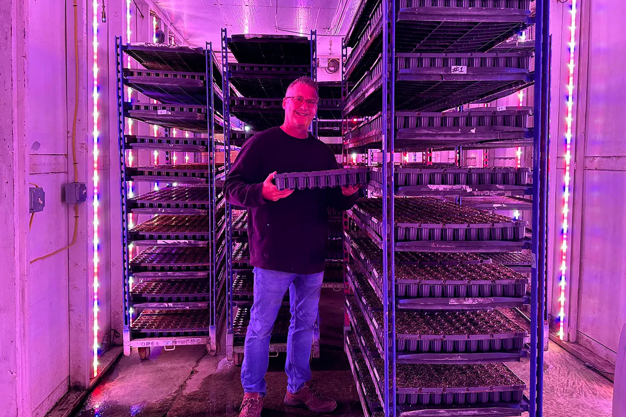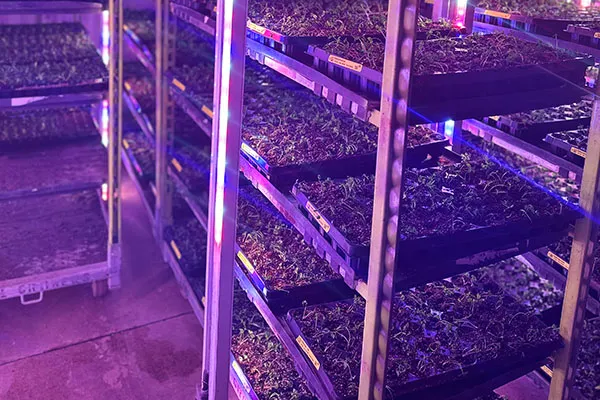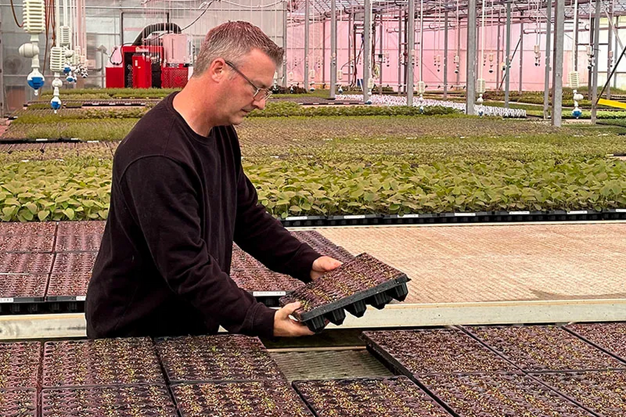Opel Growers installed LED grow lights in its germination chamber and tissue culture acclimation room to increase the number of useable, uniform plants that could be transplanted.
Opel Growers in Hudsonville, Mich., specializes in the production of over 1,000 perennial varieties along with woody ornamentals, annuals, ornamental grasses, succulents, and herbs. Its finished crops are marketed in a variety of container sizes to independent garden centers and landscaper wholesalers.
Three years ago, Paul Pilon, the company's director of growing, began looking for ways to improve the germination of its seed varieties and the transplant success of its tissue culture plants.
"One of our initial focus points was to improve how we managed these crops from day one," Pilon said. "We had been propagating these plants in the greenhouse, which was equipped with heated floors and irrigation booms. We decided to build a germination room and tissue culture acclimation room to obtain better results with our starter plants. We wanted to increase the germination of the seed crops along with improving the survivability and performance of the tissue culture plants."
The company constructed two 10- by 30-foot rooms that were designed to optimize the environment.
"We wanted a germination chamber where we could better control temperature, humidity, and light," Pilon said. "Previously the seed was sown in plug trays that were set onto heated greenhouse floors. Germinating the seed this way wasn't a problem in January when the young seedlings could tolerate the greenhouse environment. Even with a boom, if the moisture isn't managed properly in the first few days, the seedlings can be damaged negatively impacting the germination rate.
"The tissue culture plants, which are initially in sterile, stable conditions are very tender. These plants were also placed directly on the greenhouse floor. The seedlings and tissue culture plants had a much greater chance of being stressed under the higher light intensity and harsher greenhouse conditions. For the tissue culture plants we were looking to move the plants from the lab to an interim environment where they could be kept for six to 10 days before being moved into the greenhouse."
 Paul Pilon
Paul Pilon
Installing the right LED grow lights
Pilon contacted Hort Americas, a commercial horticultural distributor, to find out if the company offered the type of LED grow lights that would meet the needs of the germinating seedlings and young tissue culture plants.
"We discussed our needs with Hort Americas and decided to install Arize Life 2 LED grow lights, which were the best option for how we intended to use the lights," Pilon said. "We are using the same lights in both the germination chamber and the tissue culture acclimation room. We specifically wanted light fixtures that could be mounted vertically instead of horizontally, could tolerate the high humidity in both rooms and deliver no far-red light.
"Stem elongation is controlled with the exclusion of far-red light. Many LEDs have 5 percent far-red light. The Arize lights we installed are 77 percent red light which is good for plant growth photosynthesis as well as enhanced rooting. There is some blue light as well for maintaining crop quality, including toned growth and increased chlorophyll production."
Preventing seedling stretch
In the germination room, the 8-foot Arize light fixtures are mounted vertically on the walls about 2½ feet apart. Seed flats are placed on racks with shelves.

"The purpose of the light isn't for germination," Pilon said. "Most seeds germinate just fine in the dark. However, some varieties have a light requirement or are light beneficial during the germination phase. The secondary purpose of the lights is if not enough seedlings germinate when the radicles first emerge, they can be left in the chamber longer. The added light, with the exclusion of far-red light, ensures the seedlings won't stretch and become chlorotic."
Most of the varieties in the germination room are ready to pull out in three to six days. A few slower germinating varieties remain in the room for 10 to 14 days.
"Previously, once radicle emergence was observed, the seed trays were removed as soon as 70 percent of the seed were showing a radicle," Pilon said. "Now that we have the germination chamber with the grow lights, we can leave the seedlings in longer and not have any adverse effects. This is especially the case with certain species in the Asteraceae family, including Echinacea. We can leave those seedlings in the chamber ½ to 1 day longer. Now when the trays are removed from the chamber, we already have a higher number of seedlings that have germinated before they go into the greenhouse.
"I have used germination chambers equipped with fluorescent lights and if I waited 2 hours longer than I should have, the seedlings were already elongated. The LED lights enable me to leave the seedlings in the germination chamber quite a bit longer. It is not as critical that I take the seedlings out as quickly."
Fluorescent light fixtures have been installed in the germination room and tissue culture acclimation room, but are not used in conjunction with the LED grow lights.
"The fluorescent lights are used when employees need to check on the seed germination and tissue culture plants," Pilon said. "The fluorescent lights make it easier to focus on the trays and plants. Being in the chamber daily, the fluorescent lights help to prevent eye strain and enable workers to see the plants."
Better germination takes more than adding light
Pilon said the benefits of using the LED grow lights in the germination room include eliminating early stretch, more consistent germination, and shorter germination times.
"We have seen a 10-25 percent increase in the germination success compared to setting the seed flats directly into the greenhouse," he said. "We have gotten a higher yield, better quality seedlings, and easier management. We used to have to check the seedling flats at least twice a day and sometimes as often as three times a day. Having installed the grow lights enables me to relax knowing that they are being checked at least once a day."
While the LED grow lights have certainly helped to improve germination, Pilon said the chamber is only one part of the production process.
"One of the things we learned through Ball Horticultural Co., which has some very good educational videos, is the moisture content of the substrate going into the germination chamber matters," he said. "We are measuring the weight of the plug trays making sure they are at a minimum weight going into the chamber. How moisture is managed when the trays come out of the chamber is also important. The seed is still sitting on top of the substrate when the trays come out and go into the greenhouse. We could lose the benefits of the chamber if the other plug stages are not managed correctly."

Using the chamber in combination with better cultural management, has enabled Opel Growers to decrease production times, increase yields, and reduce the number of plants it has had to produce over the number that are needed.
"For some varieties, overproduction was as much as 30 percent," he said. "If we needed 100 trays, we'd have to produce 130 trays to yield 100 trays. With the germination chamber, we have been able to reduce overproduction to 10 percent. Reducing the number of trays needed has affected so many things, including greenhouse space utilization, labor, cost of the plugs, the substrate, and the seed."
Toughening up tissue culture plants
In the tissue culture acclimation room, since these are plants and not seedlings, they require a higher light intensity. The Arize grow lights are mounted vertically on each side of moveable racks. Two racks are placed together so there are always two lights per rack with the light directed at the plants from each side of the rack.
"To a lesser extent with the tissue culture plants in regards to overproduction, we still have 5-10 percent depending on the perennial variety we are growing," Pilon said. "Once the plants are moved to the greenhouse, they are better able to tolerate those conditions. The acclimation room allows us to prevent having to put the plants in a harsh environment.
"We use the acclimation room year-round with most crops. The benefit of the room is more during the higher light-intensity months outside, usually mid-March through mid-September. That's when we get the biggest benefit of the room. The room provides good air movement and a higher light intensity. We also use fog, but it is less than what is used in the seed germination chamber. If we can maintain an 80-85 percent relative humidity for six to eight days that helps to toughen up the plants before they go into the greenhouse."
Missing out on the benefits of grow lights
Pilon said many growers have developed a mental mindset that because they have been operating without grow lights for so many years they don't need them.
"Growers need to understand what their goals are for the grow lights," he said. "How are the lights going to be used and what are they trying to achieve by installing the lights?
"Lighting can be very advantageous. If a grower can't justify installing lights in a 1-acre greenhouse or 10,000 square feet of greenhouse space, there are other opportunities to put lights into a small area like a germination room."
Pilon said he has seen the benefits of installing the lights.
"We have lowered our over starts from 30 percent down to 5-10 percent," he said "That is a lot less seed and fewer flats that take up less greenhouse space. We also don't have to do as much patching of flats. That means fewer fungus gnats in the empty plug cells where seedlings didn't emerge. This impacts making fewer pesticide applications.
"There are so many positive things that it's hard to put a value on, including saving time and money. We recognized that we needed to make improvements in our propagation process. Lighting is one part of those improvements."
For more information:
Hort Americas
www.hortamericas.com
Opel Growers
www.opelgrowers.com
